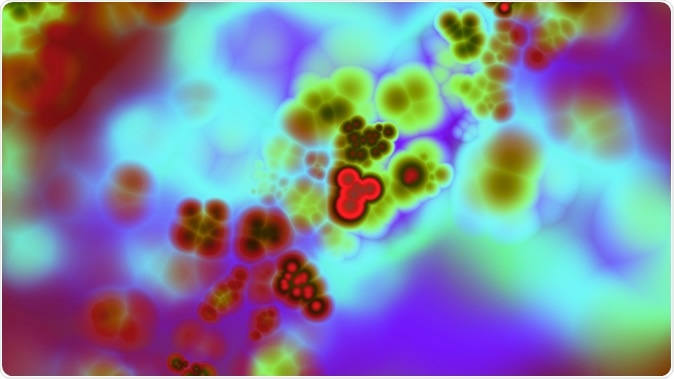Nanotechnology-based compounds are now being tested as a possible delivery vehicle for vaccines. A team of researchers demonstrated how the oral delivery vehicle SBA-15, one such nanotechnology-based compound can deliver an oral vaccine against hepatitis B to the immune system.
The researchers, who were from Brazil and Europe, showed that the nanotechnology-based delivery system, which are particles containing silica and the HBsAg, the hepatitis B surface antigen, reach the intestines without being destroyed by the stomach’s acidity. The study could pave the way to develop new vaccines and delivery modes that are safe and non-invasive.

Nanotechnology biomedical imaging illustration. Image Credit: HaHanna / Shutterstock
The Hepatitis Vaccine
The oral delivery of antigens for vaccination is an attractive idea for scientists mainly because they’re non-invasive in nature, safe, and painless in infants. Plus, oral delivery is cost-effective, making it a good proposition in immunization.
However, developing a technology that enables oral vaccines to be effective remains a very hard endeavor, since there are many problems to address. First off, the vaccine should be delivered into the intestines without being altered or damaged by the acids in the stomach. The key objective is to make sure the delivery system can withstand the harsh conditions within the gastrointestinal tract.
Hepatitis B is a vaccine that helps protect the body against Hepatitis B, which is caused by a virus. It can lead to liver inflammation, and in the long run, can cause scarring of the organ, liver failure, and cancer. The virus can be acquired through exposure to blood, semen and other body fluids. A mother can also pass down the virus to her children through pregnancy.
The hepatitis B vaccine is usually given through intramuscular injection upon birth, at least one month after the initial shot, and at least 2 months after the 2nd shot. Booster doses are given every five years.
Nanotechnology-based delivery system
The study, which was published in the journal Scientific Reports and supported by the São Paulo Research Foundation - FAPESP and European research funders, shows how a viable approach, the hepatitis B oral formulation in the nanostructure silica SBA-15, can be an effective mode to deliver the oral vaccine.
Scientists at the University of São Paulo's Physics Institute (IF-USP) in Brazil developed the nanostructured silica and Butantan Institute developed the oral antigen. The SBA-15 silica and antigen were submitted to various types of X-ray imaging in European laboratories.
To land to the findings, the researchers studied how 22 nanometers-sized antigen binds to silica nanotubes with a diameter of about 10 nanometers and a honeycomb-like structure. One nanometer, abbreviated as 1 nm, is a billionth of a meter.
Examinations revealed the measurements of both the silica nanotubes and antigen using small-angle X-ray scattering (SAXS), transmission electron microscope, and dynamic light scattering (DLS).
“Despite the size difference, tests [in animals] produced an excellent immune response to the oral vaccine - as good as the injectable form or better," Márcia Fantini, study co-author and a professor at the IF-USP, said.
The 3D images gathered through the various techniques showed that despite the antigen not entering the nanotubes, it remained in 50 nm macropores between the nanotubes, which mean the antigen was protected from the stomach’s acids.
Hence, the researchers now know the ideal proportion of both compounds, so the antigen did not agglomerate, preventing it from dispersing the active antigen in the intestine.
“To conclude, the results obtained with HBsAg encapsulated antigen are the first to demonstrate how SBA-15 protects the antigen for oral administration of the hepatitis B vaccine. Encapsulated vaccines combine the advantages of immunization with the ease of administration by the oral route and concomitant induction of the immune response,” the researchers concluded in the study.
The scientists plan to test polymers that can coat the entire structure. This way, the antigen’s resistance to the acidity of the human stomach can be strengthened and increased.
Meanwhile, some of the scientists led by Bordalo, Sant’Anna, and Fantini are developing new antigens to add to the compound. So, aside from hepatitis B, they plan to add more such as antigens against diphtheria and tetanus.
What’s more, they plan to formulate a polyvaccine that can also help immunize people against poliomyelitis, whooping cough, and Haemophilus influenza type B (Hib), a vaccine that protects people from pneumonia, and meningitis.
Journal reference:
Martin K. Rasmussen, Nikolay Kardjilov, Cristiano L. P. Oliveira, Benjamin Watts, Julie Villanova, Viviane Fongaro Botosso, Osvaldo A. Sant’Anna, Marcia C. A. Fantini & Heloisa N. Bordallo, Scientific Reportsvolume 9, Article number: 6106 (2019), https://www.nature.com/articles/s41598-019-42645-5